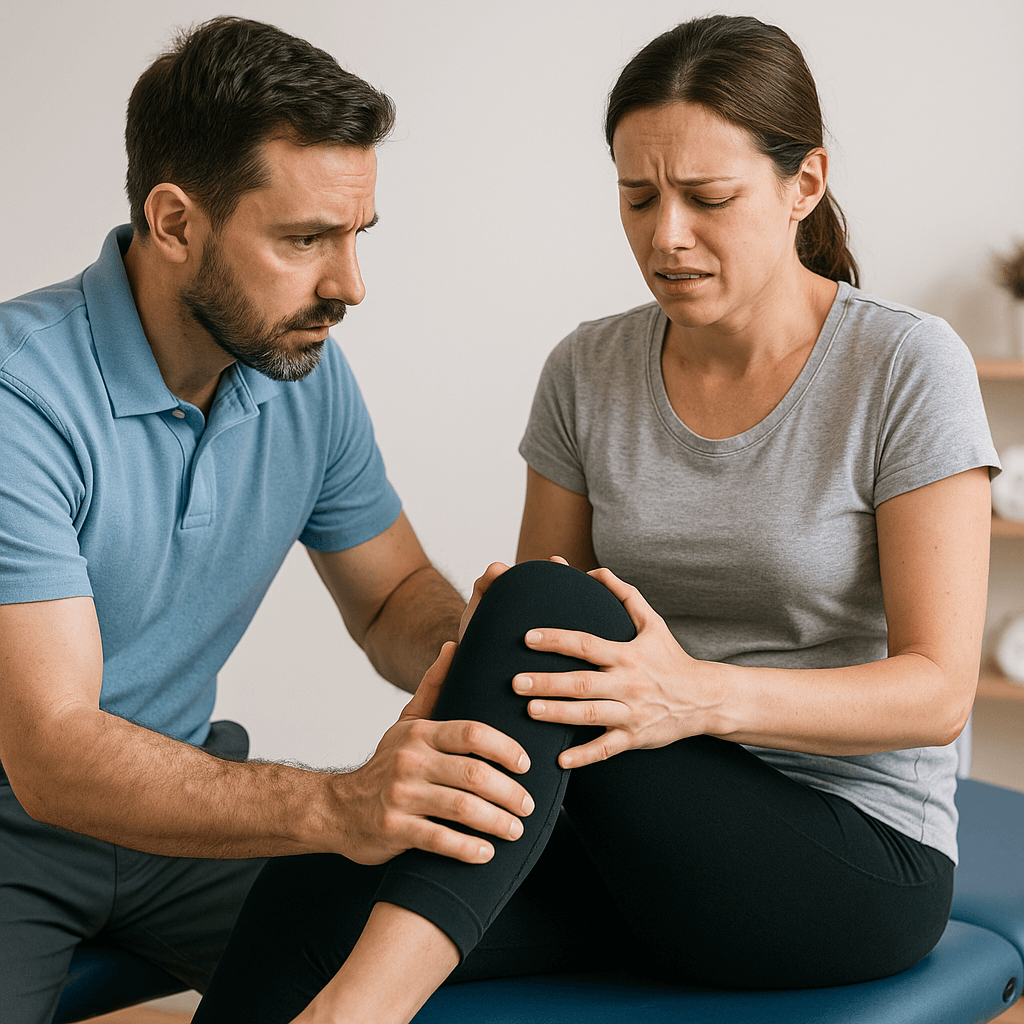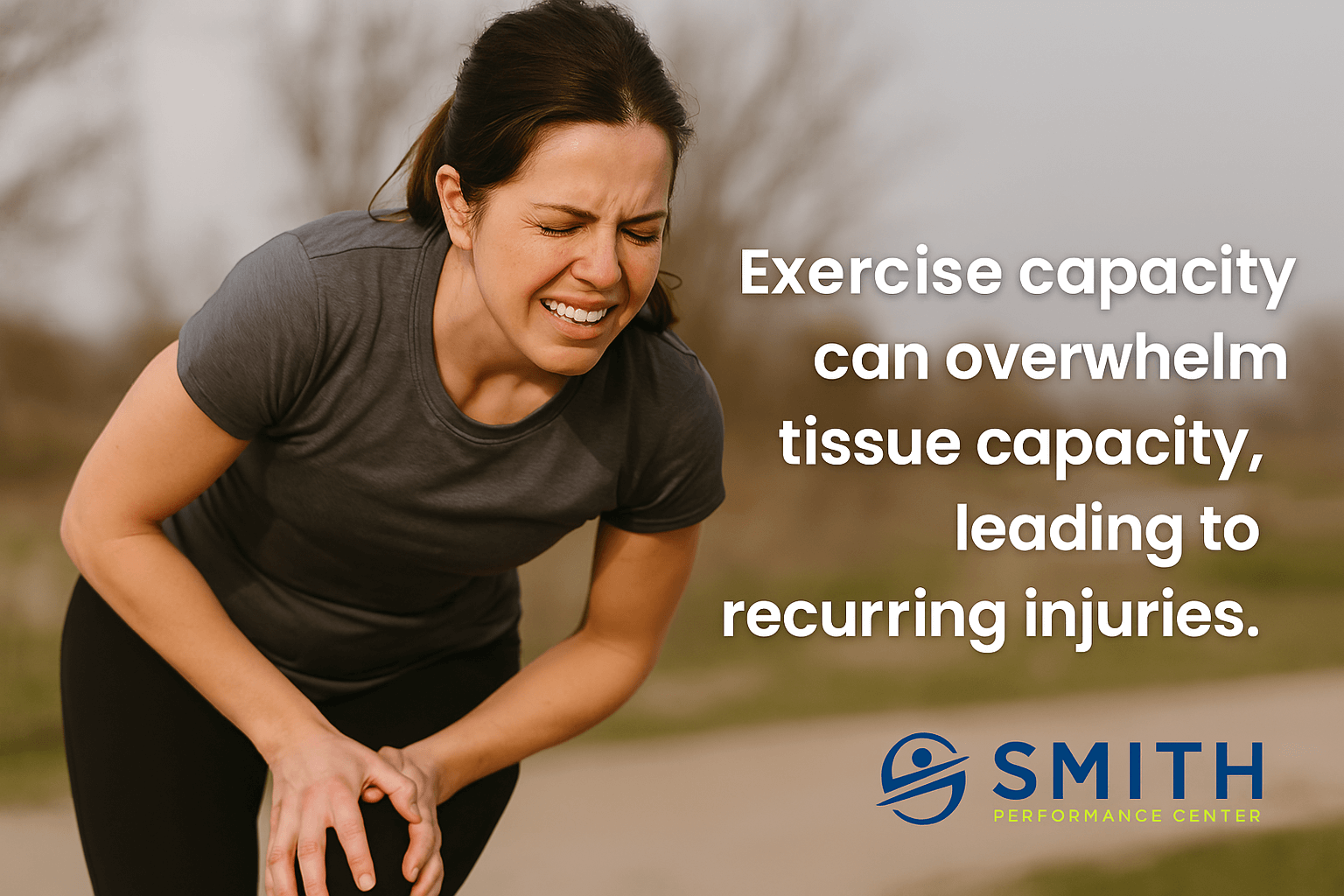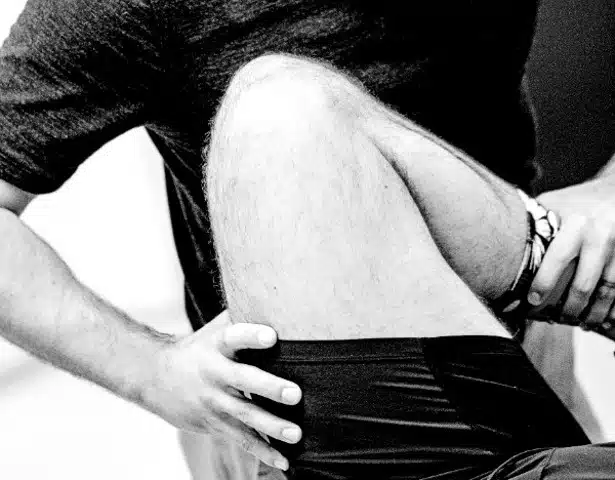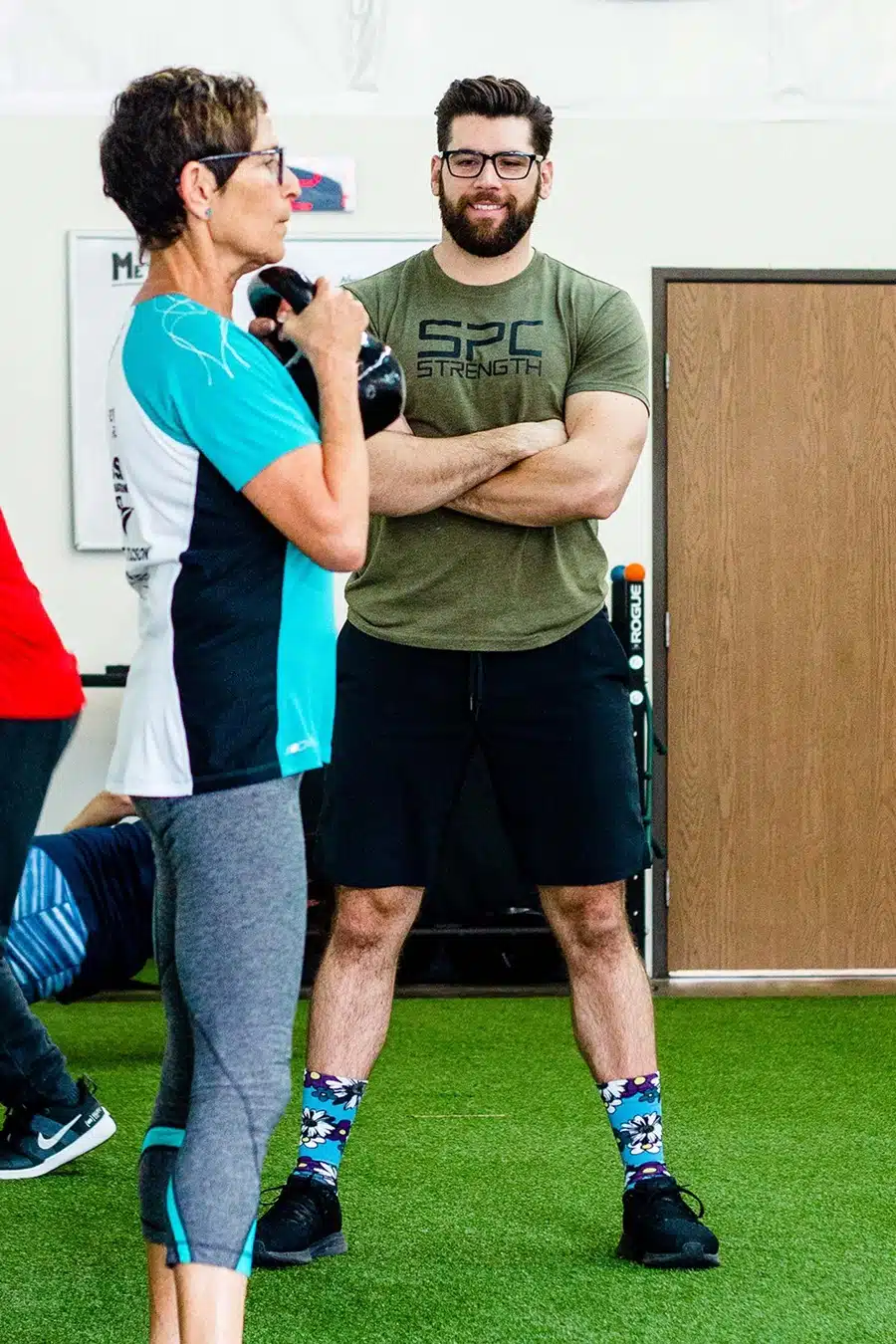Background: A Frequently Injured Triathlete
Meet Alex, a triathlete who thrives on the challenge of training and competition. But over the years, he’s been held back by recurring injuries—chronic calf cramping, back pain, neck discomfort, and knee pain. Despite trying physical therapy, stretching, massage, and adjusting his training, setbacks continued to derail his progress.
Alex’s story isn’t unique. Triathlon blends three demanding sports—each with its own mechanical load and recovery demands—leading to complex injuries and delayed feedback loops that make accurate diagnosis and injury management harder.
At Smith Performance Center, we use our five-phase system to break this cycle that often happens in triathlon injury rehab. Here’s how Alex worked through the phases and returned to consistent, high-level training.

Phase 1: Diagnostics and Home Plan Development
Problem
Alex doesn’t know what’s causing his pain. He’s avoiding or modifying the activities he loves and doesn’t trust his body anymore.
Approach
Phase 1 is about diagnostic clarity. We use four diagnostic pillars:
- Structural: Tissue damage or degeneration
- Functional: Deficits in mobility, stability, or control
- Treatment Response: What immediately changes symptoms
- Triggers: Activities or conditions that worsen or improve pain
Triathlon injuries are complex. We need to understand whether the issue shows up in the basic exam or only under sport-specific load. That clarity defines what to treat—and what to ignore.
Goal
Understand what’s wrong, reduce symptoms, and create a home plan that works immediately.
Steps to Complete Phase 1
- Confirm the source(s) of pain
- Replicate symptoms with physical tests
- Develop a reliable key sign
- Reduce symptoms through in-session treatment and the home plan
- Build the first version of the home plan
- Set patient-driven goals
- Establish testable feedback loops
- Identify early triggers to support the diagnostic process
Promise
Alex will leave with a clear diagnosis, a working theory for his pain, and a home plan that already helps—no guesswork.

Phase 2: Symptom Stabilization
Problem
Alex feels better after treatment sessions but can’t consistently manage symptoms on his own. He’s not confident training without external support.
Approach
Symptom stabilization is about control—building the skill to self-manage pain, identify triggers, and stop flare-ups before they escalate. For triathletes, hidden interactions between sports and lifestyle often create confusing flare patterns. Alex needs to catch them early and act.
Goal
Alex can consistently manage his symptoms with his home plan, returning to normal training levels without setbacks—though ramping up still requires care.
Steps to Complete Phase 2
- Build Alex’s ability to resolve symptoms independently
- Expand the trigger list as training volume increases
- Refine key signs and ensure daily usability
- Address contributing factors (e.g., strength imbalances, poor movement)
- Practice real-time symptom management during training
- Reinforce home plan routines for symptom control
- Reduce dependence on meds, modalities, or frequent clinician visits
Promise
Alex will train consistently without being derailed by flare-ups—and knows how to intervene early if symptoms return.
Phase 3: Activity Progression
Problem
Alex is active again but keeps overshooting what his body can handle. He feels worse the day after harder sessions and doubts whether a pain-free lifestyle is even possible.
Approach
This phase is about building tissue capacity, not just tolerating workouts. Triathletes with prior training may overestimate their load tolerance. We focus on progressive, well-paced volume increases across swim, bike, and run—especially the high-impact elements like running.
Goal
Alex can increase training using a system that balances tissue capacity with sport demands—without recurring injury.
Steps to Complete Phase 3
- Establish training baselines for swim, bike, run, and strength
- Use feedback loops and key signs to guide progress
- Start with lower-impact progressions (e.g., uphill treadmill running)
- Introduce strength work targeting weak or inhibited areas
- Monitor delayed symptom response (especially day-after pain)
- Address lingering movement inefficiencies
- Plan strategic deload weeks
- Expand the home plan to support recovery and load adaptation
- Coordinate sport-specific workload to prevent overload
Promise
Alex will rebuild a durable foundation for training and racing, progressing without falling into the injury-reinjury loop.
Phase 4: Exercise, Maintenance, and Monitoring
Problem
Alex is no longer injured but needs a structured approach to build performance and avoid backsliding. Time and energy are limited, and poor planning risks re-injury.
Approach
The off-season becomes a critical window for rebuilding strength, addressing imbalances, and laying the foundation for the next season. Minor issues that don’t cause pain in-season often lead to future breakdowns if ignored.
Goal
Build a sustainable, well-rounded program that supports long-term training and race performance.
Steps to Complete Phase 4
- Strength train 3x/week to build capacity
- Address injuries or inefficiencies that weren’t prioritized in-season
- Keep endurance sessions easy while focusing on technique
- Use goal-based blocks to develop targeted adaptations
- Reinforce injury prevention and performance skills (e.g., swim mechanics, bike fit, run gait)
- Maintain regular check-ins or Open Clinics to spot early issues
- Adapt the home plan to fit the demands of this phase
Promise
Alex will be able to train with confidence, balance his schedule, and stay on track for next season’s peak performance.
Phase 5: Maximize Performance
Problem
Alex wants to hit new PRs and compete at a higher level—but every time he pushes hard, his body breaks down.
Approach
Peak performance requires more than hard work. This phase aligns training volume, recovery, injury history, and sport-specific demands into a plan that supports long-term growth without overtraining or re-injury.
Goal
Alex reaches his competitive goals while maintaining the resilience he’s built over the prior phases.
Steps to Complete Phase 5
- Design a high-performance plan based on Alex’s past injury risk
- Monitor for early signs of tissue breakdown using key signs
- Use real-time load adjustments based on training response
- Incorporate advanced loading strategies and sport-specific drills
- Align in-season and off-season training to injury history
- Reinforce fatigue management and recovery strategies
- Provide coach-driven accountability and programming oversight
Promise
Alex will push his limits with confidence, perform at his best, and stay healthy doing it.
Summary:
Through the SPC Phase System, Alex moved from constantly battling setbacks to confidently managing his training, handling flare-ups, and chasing performance goals without fear.
Whether you’re training for your next Ironman or just trying to stay active without crashing every few weeks, the SPC system adapts to your needs while holding a clear standard for progress.
Can we help?
Tired of hitting the same wall in training?
Don’t just rehab. Rebuild smarter.
Schedule a Movement Assessment or Physical Therapy Evaluation at Smith Performance Center to start your injury-free comeback today.







